Summer is here, and so are the high electricity bills. But, there’s a way to stay cool without spending too much. I’m about to share 10 simple tips to make your home comfortable without breaking the bank.
I’ve been there too. The heat, the guilt over the thermostat, and the fear of the bill. But, I found ways to beat the system and save money. You can too, without losing any comfort.
Key Takeaways
- Discover 10 proven energy-saving tips to lower your summer electricity bill
- Learn how to understand and analyze your home’s energy consumption patterns
- Optimize your air conditioning system for maximum efficiency and cost savings
- Explore natural cooling methods and energy-efficient lighting solutions
- Manage your appliances and home electronics to reduce standby power usage

Understanding Your Home’s Energy Consumption Patterns
Getting to know your home’s energy consumption is key to cutting down on electricity usage and bills. By looking at your electricity bills and finding out when you use the most energy, you can make smart choices. These choices can lead to big savings.
Reading and Analyzing Your Electricity Bills
Your monthly electricity bills are full of clues about your home’s energy consumption. Spend some time going over these statements. Look for important details like:
- Total energy consumption (kWh) for the billing period
- Cost per unit of electricity usage
- Comparisons to previous billing cycles or the same period last year
- Any additional fees or charges that may be impacting your overall bill
Identifying Peak Usage Hours
Finding out when you use the most electricity can help you save. Adjusting your energy use to off-peak times can lower your electricity bill. Look for high energy consumption times and see if you can change your habits to use less.
Common Energy-Wasting Habits
Spotting and fixing common energy-wasting habits can save you a lot on your electricity bill. Some big offenders include:
- Leaving lights and electronics on when not in use
- Inefficient use of heating, ventilation, and air conditioning (HVAC) systems
- Excessive use of high-energy appliances during peak hours
- Failing to properly maintain and upgrade energy-efficient home systems
By understanding your home’s energy consumption patterns, you can take steps to use less electricity. This knowledge is crucial for finding ways to make your home more energy-efficient.
Smart Thermostat Installation and Programming
Getting a programmable thermostat can really help cut down your electricity bills this summer. These energy-efficient temperature control devices let you manage your home’s cooling needs with ease. They help you stay comfortable while saving energy.
A smart thermostat changes temperature settings based on your daily life. It raises the temperature when you’re not home or asleep. This way, you save on cooling costs without losing comfort.
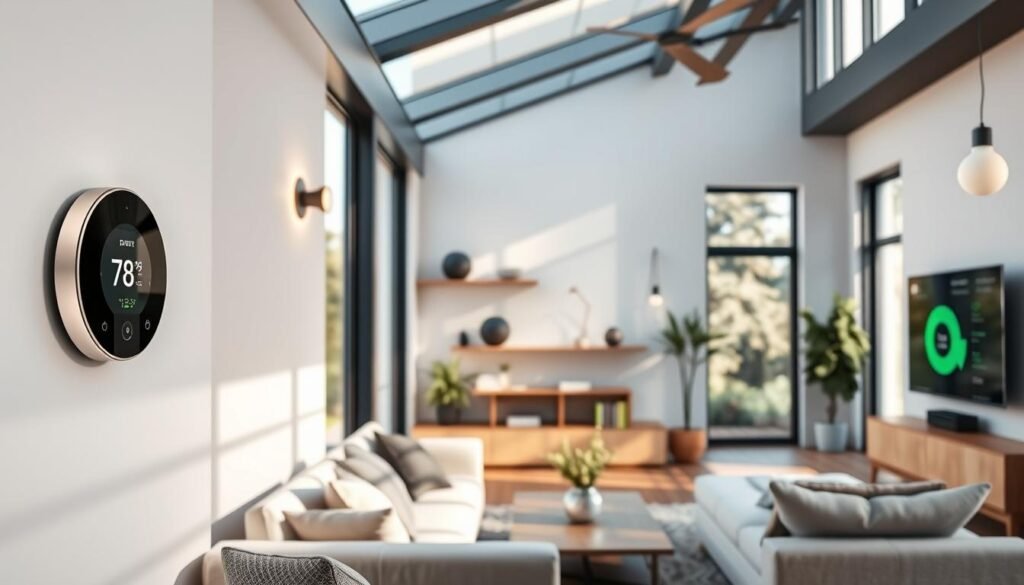
Today’s smart home devices, like Wi-Fi thermostats, let you control your home’s temperature from your phone. You can adjust the cooling schedule in real-time. This ensures your home is comfy when you’re there and saves energy when you’re not.
Installing and setting up a smart thermostat might seem hard, but it’s actually easy. Many come with simple interfaces and guides. This small change can save you money all summer long.
Optimize Your Air Conditioning System
Keeping your air conditioning (AC) system in top shape is vital. It helps keep your home cool and your electricity bills low. By taking a few easy steps, you can make your AC work better and save energy all summer.
Regular AC Maintenance Tips
Regular care is essential for your AC’s best performance. Here are some tips:
- Change air filters every 1-3 months to improve airflow and reduce energy consumption.
- Clean the outdoor condenser unit regularly to remove debris and improve heat exchange.
- Schedule annual professional tune-ups to check refrigerant levels, clean coils, and identify any issues.
Ideal Temperature Settings
Finding the perfect temperature is key. The U.S. Department of Energy suggests:
Set your thermostat to 78°F (25.5°C) when you’re home. When you’re away, set it to 85°F (29.4°C). This small change can make a big difference in AC efficiency and energy-saving cooling tips.
Using Ceiling Fans Effectively
Ceiling fans can help your AC system work better. They make the air feel cooler and more comfortable. Here’s how to use them best:
- Run ceiling fans in a counterclockwise direction to push cool air down.
- Adjust the fan speed based on the room temperature and your comfort level.
- Turn off ceiling fans when the room is unoccupied, as they cool people, not the entire space.
By following these HVAC maintenance tips and energy-saving strategies, you can make your air conditioning system more efficient. This will save you money all summer.
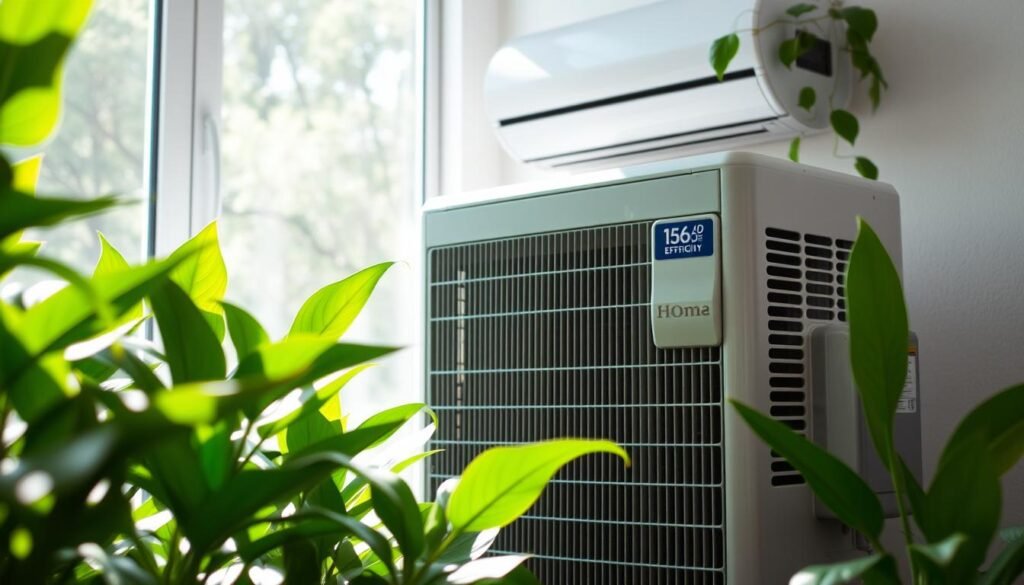
Natural Cooling Methods for Your Home
Summer heat can make your electricity bill soar. But, there are natural ways to cool your home without spending a lot. Let’s look at some effective ways to keep your home cool without using too much energy.
Leverage Cross-Ventilation
One great way to cool your home is through cross-ventilation. Open windows on opposite sides of your house. This lets cool air flow through, making your home cooler.
Strategic Window Management
Using windows wisely is crucial for cooling. Close windows during the day to keep out hot air. Open them at night when it’s cooler. Also, think about using shades, blinds, or awnings to block sunlight and keep your home cooler.
Harness the Power of Landscaping
- Plant shade trees around your home to block sunlight.
- Use climbing vines or trellises to shade walls and windows.
- Place potted plants near windows to help cool your home.
Using these natural cooling methods can cut down on your need for air conditioning. This makes your home more comfortable and saves you money during the summer.
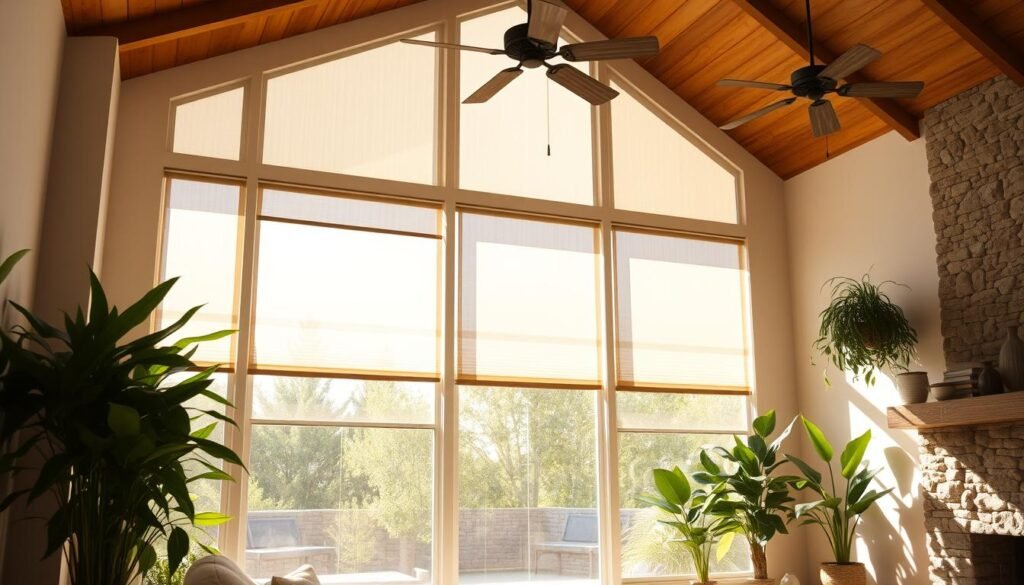
“Harnessing the power of nature can be a game-changer in reducing your home’s energy consumption and electricity bills.”
Energy-Efficient Lighting Solutions
Lighting is key in our homes but can also raise our energy use and bills. Luckily, there are many ways to cut down on energy costs without sacrificing light or comfort. These include using energy-saving bulbs and smart light controls.
LED vs. Traditional Bulbs
Switching to LED lighting is a smart move for saving energy. LEDs use up to 80% less power than old bulbs. They also last much longer, up to 25,000 to 50,000 hours, saving you money over time.
Smart Lighting Controls
Adding smart light fixtures and controls can boost your energy savings. These systems let you control lights from afar, turning them on only when you need them. Some even have motion sensors, timers, and voice commands for easier energy use.
Natural Light Maximization
- Placing windows and skylights right can let in more natural daylighting, cutting down on artificial light use.
- Keeping windows clear of curtains or blinds lets in more natural light.
- Using light-colored paint and reflective surfaces helps spread natural light around your home.
By using these energy-saving lighting options, you can lower your electricity bills and help the planet.
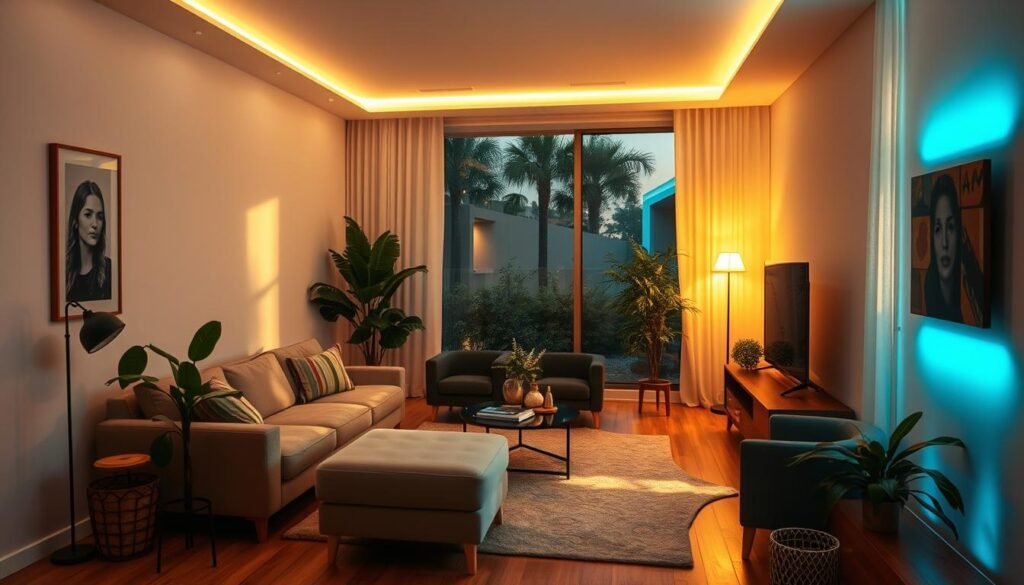
How to Reduce Electricity Bill Through Appliance Management
Managing your home’s appliances is a key strategy for lowering your electricity bill, especially during the hot summer months. By adopting energy-efficient practices and leveraging the latest technology, you can minimize energy consumption without sacrificing convenience or comfort.
One of the most effective ways to reduce energy usage is to choose energy-efficient appliances when replacing old or outdated models. Look for the ENERGY STAR label, which indicates that the appliance meets strict energy efficiency guidelines set by the U.S. Environmental Protection Agency (EPA). These appliances typically use 10-50% less energy than standard models, translating to significant savings on your electricity bill.
In addition to energy-efficient hardware, be mindful of the power-saving modes available on many modern appliances. Utilize features like sleep mode, eco mode, or delayed start to minimize energy consumption during periods of inactivity or non-peak hours.
| Appliance | Energy-Saving Tips |
|---|---|
| Refrigerator | Ensure proper door sealing, avoid opening the door frequently, and set the temperature to the recommended range (35-38°F for the fresh food compartment and 0°F for the freezer). |
| Washing Machine | Use cold water settings, run full loads, and take advantage of energy-efficient cycles like eco or delicate modes. |
| Dishwasher | Run only full loads, use the air-dry or energy-saving drying options, and avoid the heated drying cycle. |
By implementing these practical strategies for managing your home’s energy-efficient appliances, you can take a significant step towards reducing your electricity bill and contributing to a more sustainable energy future.
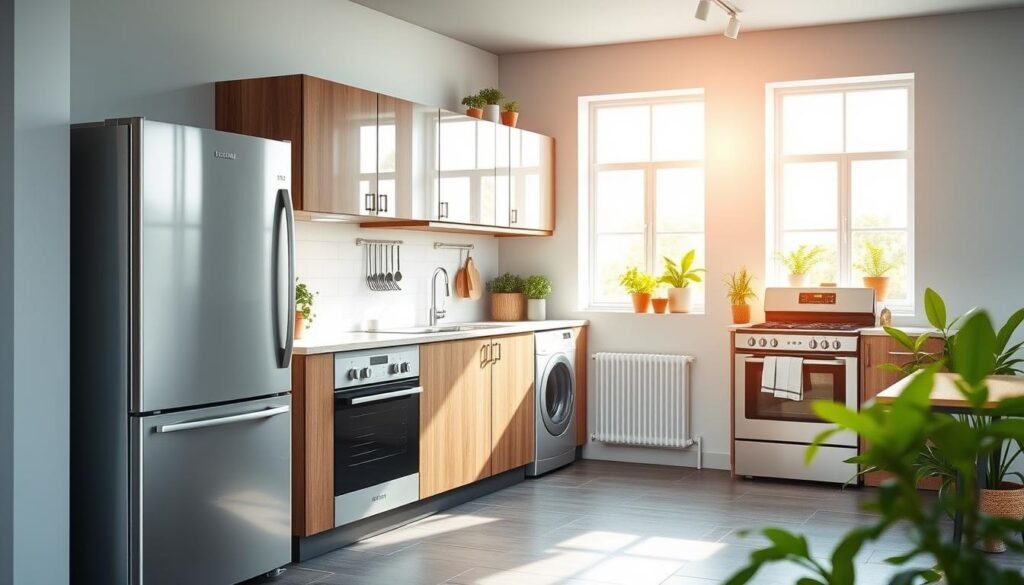
Sealing and Insulation Techniques
Sealing and insulation are key to lowering your home’s energy use and bills, especially in summer. By fixing air leaks and boosting insulation, you can make your home cooler without always using the AC.
Window and Door Weather Stripping
Weather stripping around windows and doors is a simple yet effective way to seal your home. It stops cool air from leaving and hot air from getting in, easing your AC’s work. Choose durable weather stripping that keeps a tight seal for a long time.
Attic Insulation Benefits
The attic can let a lot of heat in during summer, as sunlight easily enters an under-insulated space. Adding more insulation to your attic can greatly help keep your home cool and cut down on electricity bills. Good attic insulation keeps your home at a comfortable temperature, reducing the need for too much AC.
| Insulation Type | R-Value Range | Recommended R-Value for Attics |
|---|---|---|
| Fiberglass Batt | R-13 to R-38 | R-30 to R-60 |
| Blown-in Cellulose | R-13 to R-40 | R-30 to R-60 |
| Spray Foam | R-15 to R-50 | R-30 to R-60 |
By using the right sealing and insulation, homeowners can cut down on home insulation costs. They’ll enjoy a more comfy, energy-saving living space. This also means big savings on energy-efficient windows and air leaks bills, helping with overall weatherization efforts.
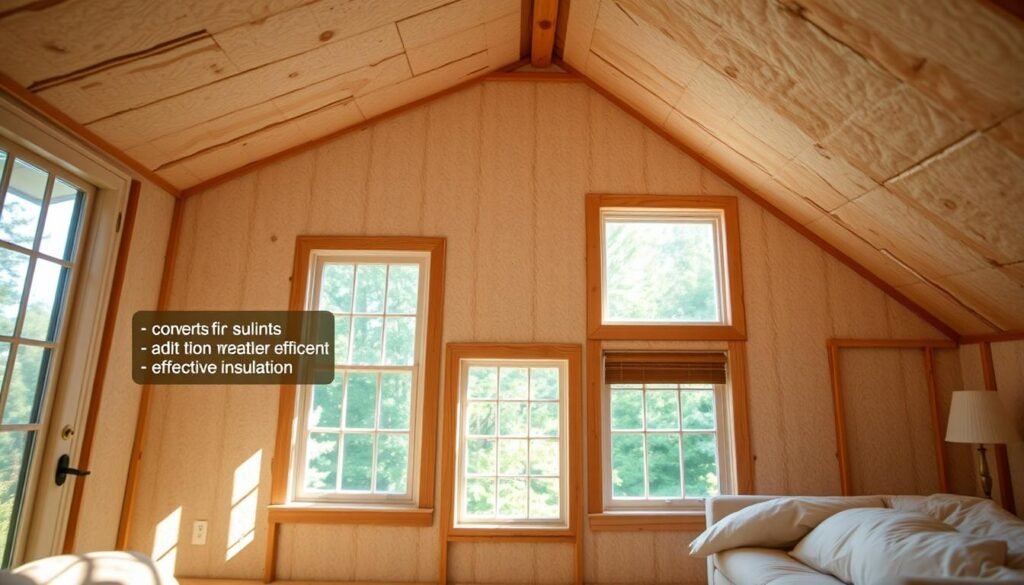
Smart Power Strip Usage and Standby Power Management
In today’s homes, tech devices and appliances are key to our daily lives. Yet, they still use phantom energy or vampire power when idle. This leads to wasted electricity conservation and higher bills.
Smart power strips offer a solution. They cut off power to devices when not in use. This stops the constant use of phantom energy.
- Smart power strips detect standby mode and turn off power, stopping vampire power drain.
- They have USB ports that only charge when a device is plugged in, saving electricity conservation.
- Many come with timers to schedule device use, improving energy use.
| Feature | Benefit |
|---|---|
| Automatic Standby Mode Detection | Cuts off power to devices not in use, eliminating phantom energy consumption. |
| Programmable Timers | Allows you to schedule when devices should be powered on and off, optimizing electricity conservation. |
| USB Charging Ports | Only provides power when a device is connected, reducing vampire power draw. |
Using smart power strips can greatly reduce phantom energy and vampire power. This leads to big savings on your electricity conservation bills.
“Smart power strips are a game-changer in the fight against phantom energy and vampire power. They make it easy to keep your home energy-efficient without sacrificing convenience.”
Time-of-Use Rate Benefits and Strategic Usage
Utility companies offer time-of-use electricity rates to help cut down your energy costs. Knowing the difference between peak and off-peak hours is key. This lets you plan when to use energy-hungry activities to save money during off-peak times.
Peak vs Off-Peak Hours
Peak hours are usually during the day, from 4 PM to 9 PM, when everyone uses more electricity. This is when rates are higher. Off-peak hours, like nights and weekends, have lower rates because there’s less electricity use.
Scheduling Energy-Intensive Activities
- Run big appliances like dishwashers, washing machines, and dryers during off-peak hours for off-peak energy savings.
- Don’t use appliances like ovens and electric stoves during peak hours. Try grilling or using a slow cooker instead.
- Set your smart thermostat to cool your home during off-peak hours. This cuts down on air conditioning use during peak times.
- Charge electric vehicles or run pool pumps and other heavy-duty equipment during off-peak hours for better strategic power usage.
Being aware of your energy use and adjusting it can greatly lower your electricity bill. It also helps make our energy use more sustainable.
Home Energy Audit Benefits
Getting a professional energy assessment can change how you manage your electricity bills. It helps find where your home wastes energy and suggests ways to make it more efficient. This can lead to big savings on your utility bills.
Working with a skilled energy auditor gives you insights into how your home uses energy. You’ll learn how to make smart choices about energy efficiency improvements. These choices can save you a lot of money over time.
Key Benefits of a Home Energy Audit
- Find hidden energy-wasting spots like air leaks and old appliances.
- Get specific advice on energy efficiency improvements for your home.
- Learn how different upgrades can save you money and improve your home.
- Discover rebates and financing options to help with upgrades.
- Feel confident with a detailed professional energy assessment and a clear plan for saving.
| Audit Service | Description | Average Cost |
|---|---|---|
| Basic Energy Audit | Looks at your home’s energy use and offers general tips | $200 – $500 |
| Comprehensive Energy Audit | Does a deep dive with tests and specific advice | $400 – $800 |
Choosing a professional energy assessment is a smart investment. It helps you understand your home’s energy use and suggests ways to save. By making these changes, you can save a lot on your bills and make your home more comfortable and green.
“A home energy audit is the first step to identify where your home is losing energy and money, and to determine the best ways to improve efficiency.”
Conclusion
This article has given you a detailed guide to cut down your electricity bill this summer. You can learn about your home’s energy use, install a smart thermostat, and make your air conditioning more efficient. Also, using energy-saving lights can help a lot.
By sealing your home, managing your appliances, and using energy wisely, you can save a lot. A home energy audit can also show you how to save more. This way, you can find more ways to lower your electricity costs.
Even small changes can make a big difference over time. By using these tips, you’ll save money and help the planet. Start now and enjoy lower bills and a greener lifestyle.

Hello, I’m Jane, founder of Home Vibe Ideas. I’m here to inspire stylish Home Design, modern Smart Living, beautiful Outdoor Spaces, and creative DIY Projects to help you create a home that’s uniquely yours.
Disclosure: This post contains affiliate links. If you click on a link and make a purchase, we may earn a small commission at no additional cost to you. The content on this site was created with the help of AI technology.


